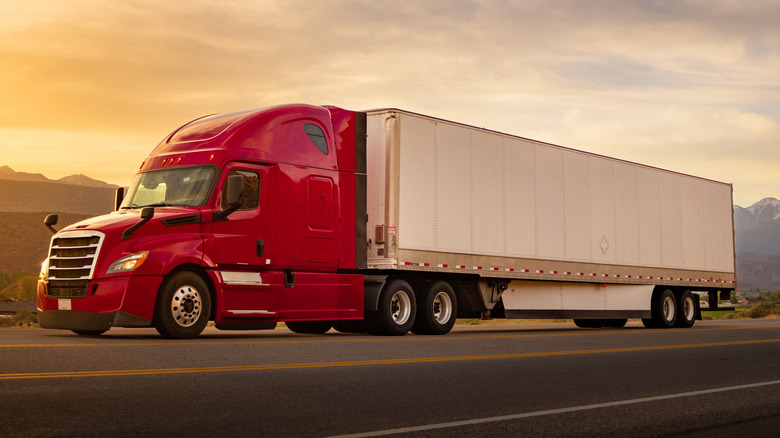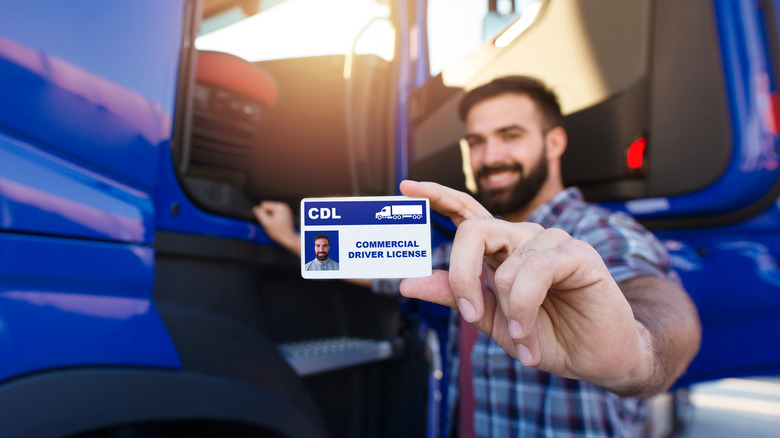What Is A Class 8 Truck, And Do You Need A Special License To Drive One?
If there's one thing that connects businesses of all sizes, it's the logistical nightmare of shipping goods from one location to another. While trucking has been used as a means of shipping products and materials across the country since the early 1900s, it didn't become a major means of transportation until the '50s, with the construction of the Interstate Highway System.
Over the decades, the trucking industry has experienced a number of transformations, particularly in trucks' design and increasingly larger sizes. That's why their classification is typically based on their maximum loaded weight, usually referred to as gross vehicle weight rating. And as these massive haulers have grown in complexity and scale, so have the ever-increasing documents and information necessary to drive semi-trucks.
The U.S. Department of Transportation uses a tiered ranking of eight classifications for trucks, with the larger numbers corresponding to an increase in gross vehicle weight. Classes 7 and 8 tend to include the heftier commercial trucks, with Class 7 covering more of the city-based vehicles like garbage and recycling trucks, or any truck weighing 26,001 to 30,000 pounds. Vehicles weighing 30,001 pounds or more are slotted into Class 8 and require a Class A commercial driver's license to operate.
Class 8 includes semi-trailers and cement mixers
Within Class 8, heavy-duty big rigs are broken down into two main categories. If the trailer is attached to the truck's chassis, it's a straight truck or straight cab. If the trailer isn't attached to the chassis, that truck is a tractor. There's also a focus on whether the semi-truck contains a sleeping compartment for the driver. Typically, sleeper cabs are used for long-distance shipments while non-sleepers, or day cabs, make local or regional deliveries. Additionally, massive specialty trucks are often covered by Class 8, including cement mixers, fuel trucks, and fire engines. (There also are different types of semi-trailers that connect to trucks in different ways.)
Given Class 8 vehicles' size, the regulations governing their use are equally substantial. Truckers hauling commercial loads of 10,000 pounds on highways are required to stop at weigh stations for inspections that can also include review of their engine, brakes, and tires. Moreover, if a class 8 vehicle is hauling an oversized load, the drivers need to procure permits, which can be difficult, as the requirements vary from state to state. And looking ahead, updated emissions regulations scheduled to be implemented in 2027 will require Class 8 trucks to install expensive catalytic reduction systems.
Looking after drivers' safety and welfare is equally important. According to the Federal Motor Carrier Safety Administration, Class 8 vehicle drivers can drive a maximum of 11 hours after a 10-hour break, and must take a half-hour break after driving for eight hours.
Earn additional endorsements for your Class A commercial license to drive other speciality vehicles
With the broad range of responsibilities drivers must manage when handling a Class 8 semi-truck, it's understandable why a Class A commercial driver's license is required operate one. While the requirements vary by state, generally an applicant for a Class A license must be at least 21 years old and have a satisfactory driving record. Additionally, applicants who received their learner's permit on or after Feb. 7, 2022 must complete an entry-level driver training program. Drivers also must pass the written and skills portions of a test; provide proof of residency and valid identification; and complete a medical examination, which they will have to re-submit every two years to remain in good standing.
Having a valid Class A license carries a number of benefits besides driving a Class 8 semi-truck. It can open up other career avenues like owning your own trucking company or driving cross-country tour buses. Employers in the trucking industry highly value these credentials, so they can increase your earning potential. Additionally, Class A license-holders can work toward qualifying for endorsements to operate specialty vehicles like livestock carriers or hazardous-waste vehicles.


